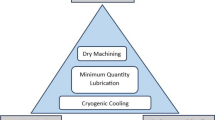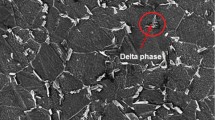Abstract
The nano-fluid system efficiency is mostly governed by the amount, structure, and characteristics of the nano-additives and the mechanism by which the nano-fluids are distributed and sprayed to the tool–workpiece interface zone. The utilization of nano-additive-based cutting fluid demonstrated significant improvement in the wear behavior of the cutting tool. They also provide excellent cooling capabilities when machining is carried out at high temperatures especially when cutting difficult-to-machine workpiece material. The present study offers an in-depth study aided with solid analysis and interpretation for the tribological phenomenon associated with the nano-cutting fluids. In the current study, a relative wear volume model has been proposed and validated for two nano-cutting fluid cases. The presented model reveals that nanotubes offer less induced abrasive wear in comparison with the nanoparticles (i.e., the ratio between the induced nanoparticles wear to the nanotubes wear ranges from 139 up to 360 when the applied forces ranges from 10 up to 3000 N, respectively). To validate the model findings, machining experiments were carried out on Inconel 718 under nano-cutting fluid minimum quantity lubrication (MQL) with different cutting parameters and nano-additive concentrations. Two nano-additives performance have been worked out with the MQL conditions, namely, alumina nanoparticles (Al2O3) and multi-walled carbon nanotubes (MWCNTs). The wear on the flank face is determined for each cutting run to evaluate the performance of both nano-cutting fluids. The model estimates found to be consistent with the experimental findings as as MWCNTs showed less tool wear compared with Al2O3 (i.e., varied from 2 up to 150% at different cutting speeds and feed rates).





Similar content being viewed by others
Abbreviations
- a :
-
The contact area radius (case I)
- A CS :
-
Interference cross-sectional area of nano-additive with surface
- A N :
-
The nominal area
- b :
-
The contact area width (case II)
- D avg :
-
Nano-additive average size
- E 2 :
-
Workpiece Young’s modulus
- F :
-
The resultant applied force
- l :
-
Nanotube length
- L :
-
Sliding distance
- MQL:
-
Minimum quantity lubrication
- MWCNTs:
-
Multi-walled carbon nanotubes
- NP:
-
Nanoparticle
- NT:
-
Nanotube
- N NA :
-
Number of nano-additives
- V NA :
-
Wear volume induced by nano-additive
- VolNA :
-
The nano-additive volume
- VB:
-
Flank tool wear
- wt.%:
-
Nano-additive weight percentage
- ρ sol :
-
The resultant nano-fluid density
- ȵ :
-
The number of nano-additives per nominal area of contact
- ø :
-
Size distribution of nano-additive
- Ϭ avg :
-
Nano-additive size standard deviation
- ν 2 :
-
Workpiece passion ratio
References
Debnath S, Reddy MM, Yi QS (2014) Environmental friendly cutting fluids and cooling techniques in machining: a review. J Clean Prod 83:33–47
Ghosh S, Rao PV (2015) Application of sustainable techniques in metal cutting for enhanced machinability: a review. J Clean Prod 100:17–34
Klocke F, Eisenblätter G (1997) Dry cutting. CIRP Ann Manuf Technol 46(2):519–526
Krolczyk G et al (2017) Dry cutting effect in turning of a duplex stainless steel as a key factor in clean production. J Clean Prod 142:3343–3354
Hegab H, Umer U, Soliman M, Kishawy HA (2018) Effects of nano-cutting fluids on tool performance and chip morphology during machining Inconel 718. Int J Adv Manuf Technol 96(9-12):3449–3458
Hegab H, Umer U, Deiab I, Kishawy H (2018) Performance evaluation of Ti–6Al–4V machining using nano-cutting fluids under minimum quantity lubrication. Int J Adv Manuf Technol 95(9-12):4229–4241
Hegab H, Kishawy HA, Gadallah MH, Umer U, Deiab I (2018) On machining of Ti-6Al-4V using multi-walled carbon nanotubes-based nano-fluid under minimum quantity lubrication. Int J Adv Manuf Technol 97(5-8):1593–1603
Hegab H, Kishawy H (2018) Towards sustainable machining of Inconel 718 using nano-fluid minimum quantity lubrication. J Manuf Mater Process 2(3):50
Mao C, Zhang J, Huang Y, Zou H, Huang X, Zhou Z (2013) Investigation on the effect of nanofluid parameters on MQL grinding. Mater Manuf Process 28(4):436–442
Rahmati B, Sarhan AA, Sayuti M (2014) Morphology of surface generated by end milling AL6061-T6 using molybdenum disulfide (MoS 2) nanolubrication in end milling machining. J Clean Prod 66:685–691
Rapoport L, Nepomnyashchy O, Lapsker I, Verdyan A, Moshkovich A, Feldman Y, Tenne R (2005) Behavior of fullerene-like WS2 nanoparticles under severe contact conditions. Wear 259(1):703–707
Lin Y, So H (2004) Limitations on use of ZDDP as an antiwear additive in boundary lubrication. Tribol Int 37(1):25–33
Ghaednia H, Jackson RL (2013) The effect of nanoparticles on the real area of contact, friction, and wear. J Tribol 135(4):041603
Funding
The authors acknowledge the financial support of Academy of Scientific Research and Technology (JESOR program), and the International Scientific Partnership Program ISPP at King Saud University (ISPP no. 0059) for funding this research work.
Author information
Authors and Affiliations
Corresponding author
Additional information
Publisher’s note
Springer Nature remains neutral with regard to jurisdictional claims in published maps and institutional affiliations.
Rights and permissions
About this article
Cite this article
Hegab, H., Umer, U., Esawi, A. et al. Tribological mechanisms of nano-cutting fluid minimum quantity lubrication: a comparative performance analysis model. Int J Adv Manuf Technol 108, 3133–3139 (2020). https://doi.org/10.1007/s00170-020-05450-3
Received:
Accepted:
Published:
Issue Date:
DOI: https://doi.org/10.1007/s00170-020-05450-3




